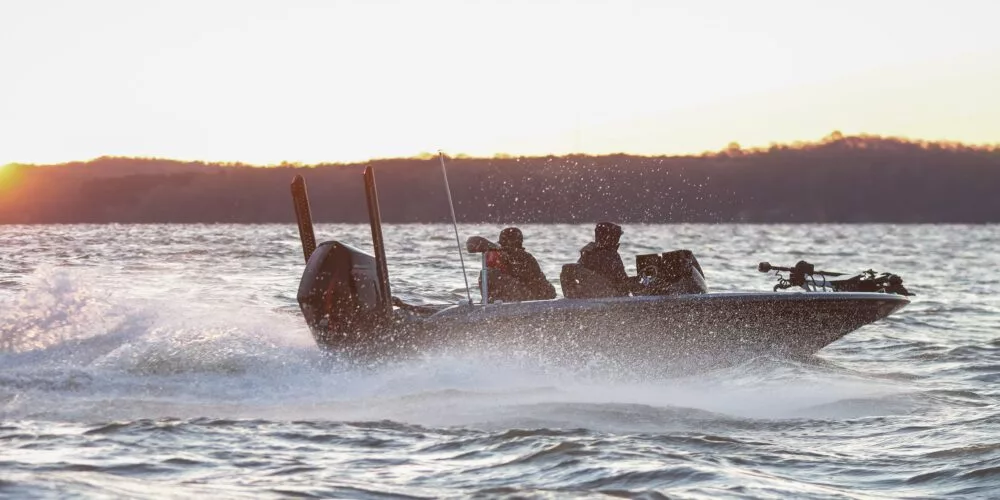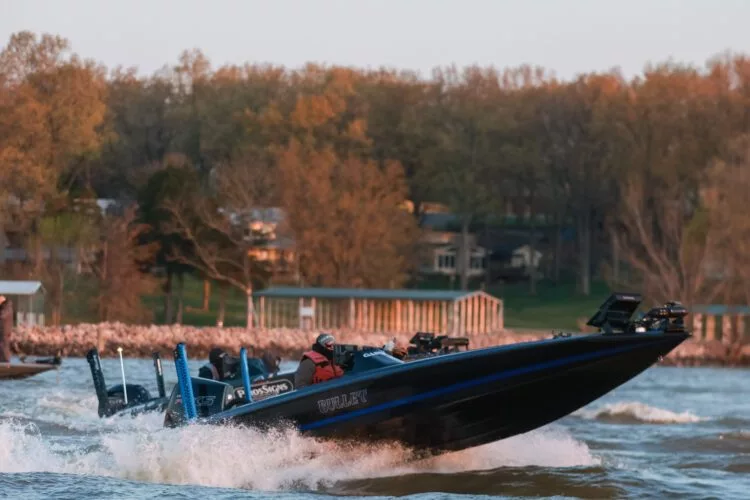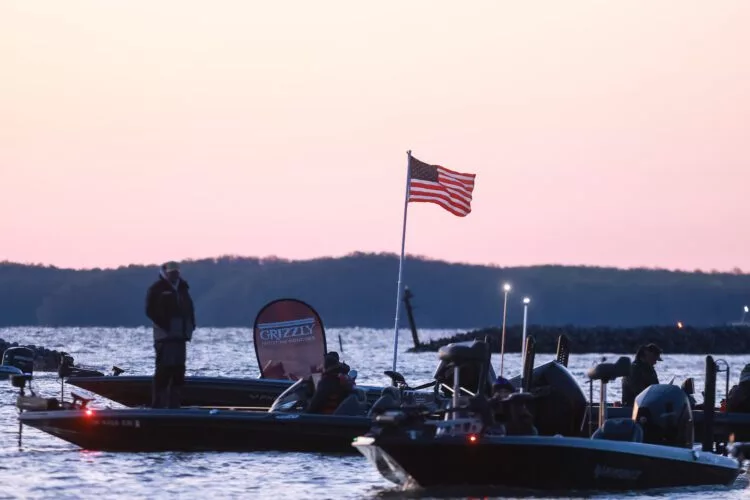
April 8, 2025 • Jody White • Toyota Series
GILBERTSVILLE, Ky. – The Toyota Series Presented by Phoenix Boats Plains Division will get underway on a wetter-than-usual Kentucky Lake. Marshall County, which encompasses the northwest side of Kentucky Lake, has received more than 15 inches of rain in the last five days and the water in both Kentucky and Barkley lakes is coming up hand over hand. So, while normal spring conditions would have things hurtling toward a prespawn and spawn smallmouth smashfest, the water conditions for this event have things in a state of extreme flux.
Rising, muddy water could define the tournament

While there’s no doubt Kentucky Lake is on the comeback, a lot of the best showings from the lake have been because of smallmouth bass caught on the main river, on flats and bars, heavily aided by forward-facing sonar. This week, that game plan could play, but it may not at all, and it certainly will not be easy.
The morning before the event, the water level on Kentucky Lake was at 357.85 feet, and per the TVA, it is projected to be 361.49 at midnight on April 9. In theory, the magical number for a flipping bite to start up is about 360, and with the water temperatures in the low to mid-60s, it’s a possibility, but there are some very complicating factors.
“I don’t mind high water, but it just continues rising each day, which means it is hard to keep up with the fish,” said Ramie Colson Jr., who has forgotten more about Kentucky and Barkley than most will ever know. “Typically if the water temperature was in the upper-60s, you know, mid-60s, then I believe you could probably go shallow, and really catch them good. You can still catch one right now, here and there, but, as far as just flipping bushes the whole tournament, no way. You can’t do it, because they’re from deep to mid to shallow – scattered.”
While rapidly rising water on its own would be one issue, the extreme amount of dirty water coming into the lake is another. Because of the nature of the Tennessee River system, rising water that stays fairly clear isn’t uncommon, but now, all the small tributaries around the lake are roiled with muddy water.
“I can probably only count on five fingers how many times I’ve seen Kentucky Lake this muddy or this dirty,” Colson said. “From one end to the other, east, west, it doesn’t make no difference. And on Barkley, what is mud on Kentucky Lake is chocolate milk over here, and there are logs charging down the river.”
Per Colson, practicing last week was “a waste of your time” with these fresh conditions, and things should change day by day. If the TVA continues to pull water through the course of the event, things might clean up a little by the final day, which a savvy angler might take advantage of. But, with the towns downriver of Kentucky Lake on the verge of flooding, the TVA could slow the current down, keeping the muddy water in Kentucky and perhaps accentuating the fast rise.
Could thinking ahead be the key?
Brent Anderson has half a dozen Phoenix Bass Fishing League wins on Kentucky to his credit, and he’s loaded with experience on Kentucky Lake, but this could be a fresh one for him.
“Everything I’m planning on fishing is still dry land right now,” Anderson said. “So I’m going to roll the dice on that. I mean, you know, if all the predictions are right, it’ll have a foot of water on it by midnight.
“Scary thing for me is, I don’t know how populated those areas are anymore,” he said. “In the day, I would know I was going to catch them. It would just be a matter of how many big ones. Now, I may be pulling into areas where fish don’t even live anymore. But, I’m excited about it.”
For Anderson, the thing that concerns him is not really the rising water, but that his history on the lake is richest south of Paris Landing, which hasn’t been the prime zone lately.
“The areas that I know to do that rising water deal are in the part of the lake that obviously has a lower population of bass now,” Anderson said. “So, I’m just not sure how many bites I could generate. I never got to learn anything on the north end of the lake under these conditions because that was the lower population of bass back around 2010. So, now I’m making a long run and turning my ‘Scope off, and we’ll see how it shakes out.”
Major change of gears for the smallmouth spawn
While Jake Lawrence has been the best on the lake when it comes to exploiting the new population of smallmouth, particularly during the spawn, Clint Knight is also an expert. When he left Norfork Lake after fishing another tournament, he had high hopes.
“Two weeks ago, I would have said it would take 23 [pounds] a day,” Knight said. “I was so excited. I left Norfolk, and I’m like, ‘Yes.’ And then I kept driving, and it kept raining. And I’m like, ‘No.’”
According to Knight, the rising water and current have washed out the chance at a big smallmouth spawn event.
“The fish started to spawn, and the majority of the fish were out there on the flats kind of like it was last year,” he said. “They were all out there. Then all of a sudden, we get 15 inches of rain, the lake rises. And now the lake TVA is generating, like, 200,000 cfs, and I think it just sucked all those fish that were out there spawning. It either sucked them through the dam or sucked them somewhere, I don’t know where they went.”
Knight expects the TVA to slow down the outflow of water on Kentucky Lake throughout the tournament, and for the lake to begin to backfill, rising to a few feet above summer pool.
“I think by the end of the tournament, the water will be at about 363 more than likely,” he said. “It’s not that high, but if you want to go fish at the golf course at Paris, you can.”
All things considered, the fishing might be good by the end of the event, or, it could still be a few days from really fun.
“Usually, what happens here is, you almost have to give them a little break,” Knight said. “They need a day to, you know, kind of see what just happened. And then, they’ll stay at the old baseline, and then they’ll rise up a day or two later once the conditions finally neutralize out. And once [the conditions are] consistent for a little while, I think they will eventually pull up, and I think the last day of the tournament will be the best day.”
What does it take to win?

This event should be fascinating to follow, and predictions for it are all over the board. Besides the conditions, it also has an interesting field – tons of Tennessee River talent, great forward-facing sonar talent, and a lot of anglers from the Ozarks. Some of those out-of-towners could do really well – experience fishing rising water will be key, and from the sounds of it, local advantage is at a minimum this week.
Pegging the winning weight at 20 pounds a day, Knight thinks we’re headed for something pretty old-school.
“I think this tournament will 100% get won on largemouth,” he said. “You’ll have one smallmouth in your bag. And two weeks ago, it would’ve 100% been won on smallmouth; if you had a largemouth in your bag, you probably wouldn’t get a check. This week, it is anyone’s ballgame. People are going to catch them suckers cranking random banks that they ain’t been on in five years.”
Figuring 65 pounds to win, Anderson thinks a broad range of tactics could play – though the water is in the low- to mid-60s, the fish aren’t behaving accordingly.
“Flipping a Beaver or something is going to definitely catch some fish, Carolina rig, maybe a ChatterBait, spinnerbait, Rat-L-Trap,” Anderson said. “It’s really weird, because we’re on the water temp where the moving bait stuff shouldn’t be playing, but it’s almost like the fish knew this was coming and they’re holding back. I would never even think of throwing a crankbait this time of year back in the day when the water is 65 degrees. I know usually when it gets in the 60s, man, in stage, I have to start dragging stuff, instead of winding stuff. But, the way the fish are acting, you would think it was March.”
If you want to add a little more uncertainty to the event, try on Colson’s predictions for size.
“I’m going to say probably 22 a day,” Colson said. “And largemouth, I don’t think will be the winning bag. Now there may be a largemouth and four smallmouth, but I think it’s going to take, you know, 20, 21, 22 a day of smallmouth, and I may be light on that.”
So, standby for weigh-in – it should help to put together what could be a fascinating puzzle of a tournament.
